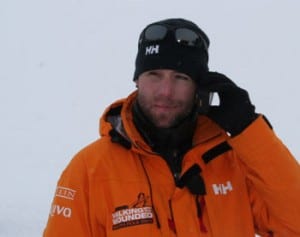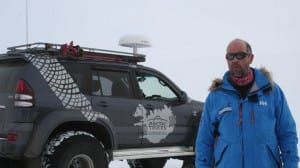Race to the bottom of the world: Calling from the South Pole
Later this year, three teams of wounded service men and women will brave the inhospitable landscape of the Antarctic Circle in a 200 mile race to the South Pole. Crevasses, blizzards, 100MPH winds and temperatures of -40 degrees are just some of the obstacles nature will throw at them as a group, beside their own individual physical and mental injuries. Earlier this month telecoms.com caught up with the teams on an Icelandic glacier as they completed a two week training session, testing the communications equipment they will use for safety and to stay in touch with home.
March 26, 2013


Chris Downey Of Team Commonwealth Using An Iridium Handset
Later this year, three teams of wounded service men and women will brave the inhospitable landscape of the Antarctic Circle in a 200 mile race to the South Pole. Crevasses, blizzards, 100MPH winds and temperatures of -40 degrees are just some of the obstacles nature will throw at them as a group, beside their own individual physical and mental injuries. Earlier this month telecoms.com caught up with the teams on an Icelandic glacier as they completed a two week training session, testing the communications equipment they will use for safety and to stay in touch with home.
The three teams: UK, USA, and Commonwealth, will set off on the four week expedition in November. During the Icelandic training exercise each team consisted of six injured service personnel, a team mentor and an experienced polar guide. But for the expedition each team will be cut back to four service personnel following a rigorous physical and mental assessment. Among the group are several amputees – both arms and legs, those suffering with gunshot wounds, shrapnel and burns, as well as one US member who is completely blind.
Organised by charity Walking with the Wounded (WWTW), this expedition is also the first of its kind that will include team members suffering from mental injuries such as post traumatic stress disorder (PTSD). Previous WWTW expeditions to Mount Everest and the North Pole have only included one leg amputee team member, so the stakes have been raised significantly this time around.

Ed Parker, Co-Founder Of Walking With The Wounded
According to Ed Parker, an ex-serviceman himself who co-founded WWTW in 2010, this is the reason the expedition needs a very robust safety net – a key element of which is communications.
“When we went to the North Pole and Everest we had a couple of Iridium handsets with us and that was it. These were great for talking to people but we weren’t able to send back any images or other information,” he says. “One of the key parts of WWTW is telling stories, trying to engage with as broad an audience as possible, and to get people to find out who these brave men and women are. In this sense Arqiva is helping us tell the story to the media.”
UK broadcast specialist Arqiva has been seconded onto the expedition to provide for all communications and safety needs. For the North Pole expedition in 2011 only four satellite handsets were taken. Admittedly the group was much smaller, but this time around 28 devices will be taken: four per team, plus those used by the support personnel, as well as plenty of spares.
This means everyone will be equipped with a handset but each team will only keep one device switched on at all times. The Lithium batteries used in the Iridium handsets don’t particularly like the cold so team members will probably take the battery out of the unused handsets and keep them in layers closer to the skin to keep them warm. Nevertheless, the expedition is taking 120 per cent spare battery holdings.
Each unit has an SOS emergency button which dials a pre-programmed phone number and sends the long-lat location and the handset’s battery status to three email addresses. In the whiteout conditions the expedition is expecting, getting lost or falling into a crevasse is a real danger. But the other reason one device on each time will be kept active is so that the interactive map tracking each team can be updated in real time. It is a race after all.
The expedition is classed as ‘unsupported’ – that is to say support personnel such as the prosthetics expert, psychotherapist, and physiotherapist among others who were present during training will not be joining the expedition. However, there will be four turbo jeeps, carrying extra supplies following the group.
One jeep in each pair will be running mirrored equipment used to get video and media from the teams onto the internet and back to the UK during the expedition.
Pete Mccormick, Project Manager At Arqiva
According to Pete McCormick, project manager at Arqiva, the solution reflects the complexity of the task at hand. “There’s only one network in town for this kind of use case and that’s Iridium. While Iridium mostly caters to maritime, it is happy to work with polar expeditions such as this too.”
Two of the turbo jeeps will carry an antenna on the roof, connected to a low orbiting satellite constellation moving around the Earth at a rate of knots. The maximum uplink connection is about 128kbps which presents two problems: bandwidth constraints when uploading video; and handover issues.
A communications officer and expedition manager travelling in the jeeps will be uploading video from a ruggedised laptop to social media sites as well as the expedition’s own website. If the connection is dropped when handing over from one satellite to another, most upload software will be forced to restart the video upload from the first frame – something which could become pretty frustrating in such extreme conditions. To combat this, as well as the bandwidth issue, Arqiva has developed and worked with software clients that can compress the video to make optimum use of the bandwidth, as well as remember where the upload got to if the session is interrupted.
Two systems will be in place. One is a store and forward, where content goes to a server in the UK and can be picked up by people working on the project back home. “Getting a two minute HD video clip every day off the ice with photos is where we want to be,” says McCormick.
The other platform is for live broadcast: “We’re going to try a live webcast from the South Pole,” he says. “And we expect a rather hefty phone bill in December.”
An Arctic Trucks Turbo Jeep
About the Author
You May Also Like












_1.jpg?width=300&auto=webp&quality=80&disable=upscale)
